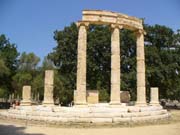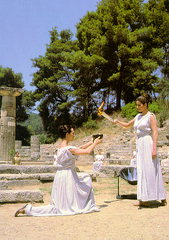OLYMPIA
Was a Panhellenic sanctuary, open to all Greeks. Every four years in late summer, thousands of Greeks from all over the known world converged at Olympia for the games held in honor of Zeus. The first Olympic Games were held in 776 BC. They continued uninterrupted for over a thousand years, until around 400BC. In the 6th c BC, an earthquake toppled all the buildings and the site was abandoned. Nearby rivers covered the site with a deep layer of silt, protecting the ruins until excavations began in 1875. The modern visitor can see the foundations of all the important buildings and can view a wide array of artifacts in a museum on the site. In 1896 the first modern Olympic Games were held in Athens.
Ancient Olympia lies 10 km. east of Pirgos, in a valley between wooded mt. Kronos, the Allfios river and its tributary, the Kladeos.
A BRIEF HISTORY OF THE GAMES
According to legend, this area was inhabited by the Pisans.There king was Oinomaus, whose daughter Hippodameia had married Pelopps.There are indications that already by 1000 BC, games were being held in honor of the couple. Though exclusively local at the start, the games began gradually to attract the interest of the other towns in the Vicinity.
In 776 BC, the leader of the Eleians, Iphitos, rededicated the games to the honor of Zeus. This date marks the first Olympiad; afterwards every four years pan-Hellenic contests were held attracting athletes from all the Greek city-states. While the games were taken place, the Olympic truce was in force and all hostilities suspended. The victor's price was a crown made from a wild olive branch, which was always cut from the same tree, the Kallistefano. "Tinella Kallinike" - Well done, glorious victor - shouted the crowd in praise of the winner. Back in his birthplace, people would knock down the city walls.
The Olympic games, which included the foot race, wrestling, the pankration, the pentathlon, chariot racing, and horse racing, as well as artistic and literary competition, come to an end in 393 AD, with the prohibitory edict of Theodosios I. Fifteen centuries later, in 1896, they were revived where they had been born, in Greece, by the French historian and educator Pier De Coubertin. Since then every four years a torchbearer, like the ancient heralds, starts out from Olympia bearing the sacred flame to the place where the Games are held. To oversee the organization of the games, an international Olympic academy was founded with headquarters since 1961 in Olympia.
THE ARCHAEOLOGICAL SITE
The first building on the left is the Prytaneion, where ceremonies honoring the winners took place. Further south Philippeion and next to it the Heraion, a Doric temple dedicated to Hera. Special running races, the Heraia, were held in her honor in which only virgins from Eleia could participate. Southwest of the Heraion lies the Pelopion, an altar dedicated to Pelopps, from whom the Peloponnese is named. Nearby is the Doric temple of Zeus (472 BC); here stood the famous gold and ivory statue of the god, a work of Pheidias. Outside the sacred grove of the Altis are ruins of other buildings: the Bouleuterion or Council House, where the athletes took the Olympic oath; the Leonidaion, used as a hostel for official visitors; the Palaistra (wrestling school), Gymnasium and the Baths. The treasures, placed at the foot of Mt. Kronos, were small edifices raised by each city to house sacrificial vessels. Next to them stands the Nymphaion, a semi-circular marble tank that held Olympia's water supply. Just beyond the treasure lie the stadium and the Stoa Poikile or Echo Colonnade, and near it Nero's house. Set in the shade stands the monument containing the heart of de Coubertin, the man who revived the Olympic games.
THE ARCHAEOLOGICAL MUSEUM
Olympia's new museum lies in a shady grove opposite to the site. Here are displayed findings from the area, like the stone head of Hera, Praxiteles' marble statue of Hermes (330 BC), the Victory by Paionios (421 BC), Miltiades' helmet, the terra cotta group of Zeus carrying Ganymede, and the sculptures from the pediments and metopes of the Temple of Zeus. There are also pottery, terra cotta and bronze figurines, votive offerings from the sanctuary, etc.
MUSEUM OF THE OLYMPIC GAMES
Very near to the ancient site lies the modern village of Olympia. Here one of its prettiest buildings houses the Museum of the Olympic Games, the only one of its kind in the world. It contains mementos connected with the history of the Games and a unique series of postage stamps, designed by Papastephanos-Provatakis commemorating the Games.

|



